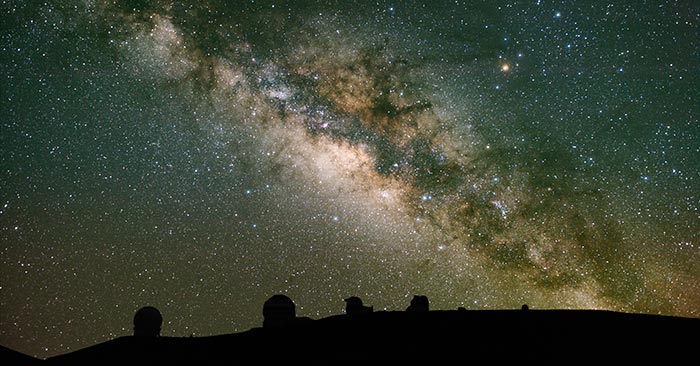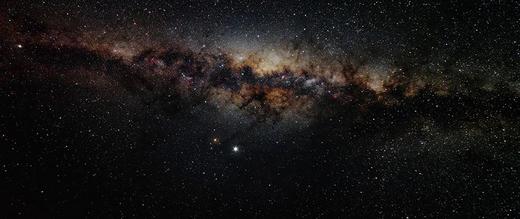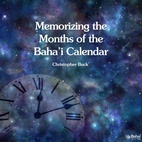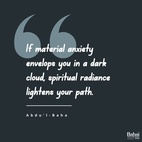The views expressed in our content reflect individual perspectives and do not represent the official views of the Baha'i Faith.
Raised in a small farm town in Central Washington State, the night sky shimmering with more light than darkness, as a small boy I lay fascinated and mesmerized on the ground, looking up. I would stare for hours.
My family wondered about me. “Where’s David?” my brothers and sisters would ask my parents. “Outside, as usual,” they would always answer. They all knew about my stargazing addiction.
No, I didn’t memorize the constellations, which always struck me as man-made memes. I knew the locations of a few twinkling stars and all the bright planets, but mere stellar geography couldn’t come close to containing the mystery I gazed into. I looked up into the great beyond with some inner desire I couldn’t name, some yearning for an unearthly purpose, some sense of the ineffable. I guess, in some way, I wanted to find God.
I knew even then that I couldn’t find the Creator by looking out into Creation. But I had some sense, even as a child, that the Great Mystery must love this endless, immense place, the universe. It seemed so obvious. I saw an endless black void, cold and airless, without life. But as I looked up from our dark farmhouse lawn, outside of the range of city lights, I could see that void dotted with billions of suns, the source of warmth and light to – who knew? – maybe trillions of planets. I yearned to know more.
 That yearning led me to science fiction. I read Ray Bradbury and Phillip K. Dick and Isaac Asimov and Arthur C. Clarke, who I would later serendipitously meet and effusively thank in the Today Show green room in New York, still awestruck at his enormous creative imagination. (Want to read a truly stunning work of fiction? Try Childhood’s End, Clarke’s masterpiece.)
That yearning led me to science fiction. I read Ray Bradbury and Phillip K. Dick and Isaac Asimov and Arthur C. Clarke, who I would later serendipitously meet and effusively thank in the Today Show green room in New York, still awestruck at his enormous creative imagination. (Want to read a truly stunning work of fiction? Try Childhood’s End, Clarke’s masterpiece.)
I spent endless nights wondering – what was up there? Did life, people, cultures, civilizations exist where other star-struck boys gazed out toward me? Then I learned in school about the vast distances in the universe, and realized that everyone who looks up at the night sky sees light from long, long ago. The closest star cluster to our sun, Alpha Centauri, is 4.2 light years away – which means that it takes a little more than four years for its light to arrive here on Earth. Other stars, millions of light years away, may be gone by now. I realized that on a clear night, when we look up, we see into the past.
Now scientists have made major advances in examining and interpreting that starlight from the past. NASA’s Kepler spacecraft began collecting data on distant stars in 2009, and a UC Berkeley scientist recently spent three years analyzing that data. He learned that one out of every five sun-like stars in the Milky Way Galaxy has a planet with surface temperatures compatible with liquid water, essential for life as we know it. And he estimates that our galaxy alone, with its 200-400 billion stars, holds approximately 40 billion similar planets.
Oh, and astronomers currently estimate that the universe contains more than a billion galaxies.
So does life exist elsewhere? The Baha’i writings, even in the 19th Century, said yes:
Thou hast, moreover, asked Me concerning the nature of the celestial spheres. To comprehend their nature, it would be necessary to inquire into the meaning of the allusions that have been made in the Books of old to the celestial spheres and the heavens, and to discover the character of their relationship to this physical world, and the influence which they exert upon it. Every heart is filled with wonder at so bewildering a theme, and every mind is perplexed by its mystery. God, alone, can fathom its import…. Know thou that every fixed star hath its own planets, and every planet its own creatures, whose number no man can compute. – Baha’u’llah, Gleanings from the Writings of Baha’u’llah, pp. 162-163.
 As a child then and as an adult now, I never could imagine that we live alone in this vast cosmos. What arrogance, I thought, to think we represent God’s only creation! The Baha’i teachings validate that idea clearly and unequivocally:
As a child then and as an adult now, I never could imagine that we live alone in this vast cosmos. What arrogance, I thought, to think we represent God’s only creation! The Baha’i teachings validate that idea clearly and unequivocally:
The earth has its inhabitants, the water and the air contain many living beings… then how is it possible to conceive that these stupendous stellar bodies are not inhabited? Verily, they are peopled, but let it be known that the dwellers accord with the elements of their respective spheres. These living beings do not have states of consciousness like unto those who live on the surface of this globe: the power of adaptation and environment molds their bodies and states of consciousness, just as our bodies and minds are suited to our planet. – Abdu’l-Baha, Divine Philosophy, pp. 114-115.
Tonight, go outside, look up and wonder.

















Comments
Sign in or create an account
Continue with Facebookor